Spotted horses always stand out from the crowd and turn heads wherever they go. But did you know their fabulous coat is not actually the work of humans?
In 2011, researchers have found genes associated with leopard spotting in the DNA of 35,000-year-old horse remnants.
Spotted horse breeds also seemed to fascinate prehistoric humans, who depicted them in magnificent cave paintings. Throughout the middle ages, they appeared in art and literature. Though Appaloosas are the most famous spotted horses, many other breeds also possess this unique coloration.
The most common spotted horse breeds are Appaloosa, Knabstrupper, British Spotted Pony, Nez Perce Horse, and Noriker. Horses with a spotted coat pattern are prized for their looks are were often gifted to royal families in the middle ages.
Here are 10 gorgeous spotted horse breeds for you to admire:
Appaloosa

olgaru79 / Shutterstock.com
The Appaloosa’s eye-catching pattern comes from the spotted horses brought into the Americas by Spanish Conquistadors. Known as the Dalmatian horse breed, it was bred in the mid-18th century by the Native American Nez Perce people. Its name comes from the Palouse River that flows through what used to be Nez Perce territory.
The Appaloosa has quickly spread around the world and became one of the most popular horse breeds in the United States. Due to its many body types, the Appaloosa is a popular choice for both English and Western disciplines.
Interestingly, not all Appaloosas have spotted markings. Solid coloured horses also occur, but they will always have mottled skin and either striped hooves or a visible white sclera around the eyes.
Knabstrupper
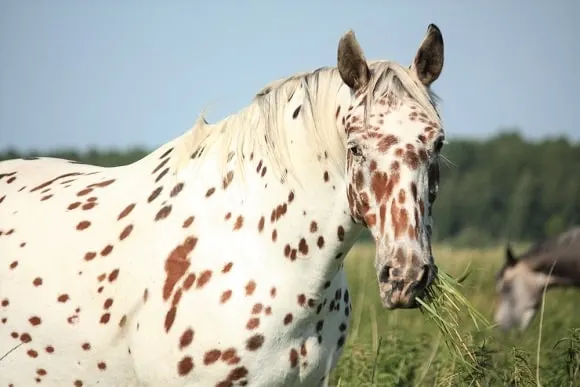
Anastasija Popova / Shutterstock.com
Similarly to Appaloosas, Knabstruppers originate from prehistoric spotted horses. The Knabstrupper is native to Denmark and exists since 1812. The breed soon spread across Europe and later to North America, Australia, and New Zealand.
Knapstruppers were crossbred with Appaloosas on several occasions to save the breed from extinction. However, the two breeds developed independently from each other.
The Knabstrupper is a versatile breed that performs equally well under saddle and in harness. Its fabulous spotted coat makes these horses ideal for parades and circus shows.
British Spotted Pony

This adorable pony breed inherited its marvelous coat from prehistoric spotted horses. The official British Spotted Horse and Pony Society dates back to 1947. The breed has since received Knabstrupper and Appaloosa blood to help preserve its unique coloration.
With only around 800 registered ponies, the British Spotted Pony is one of the rarest horse breeds on the planet. Its height varies between 8 and 14.2 hands, which makes them an excellent child’s pony, pet, or companion animal.
Nez Perce Horse
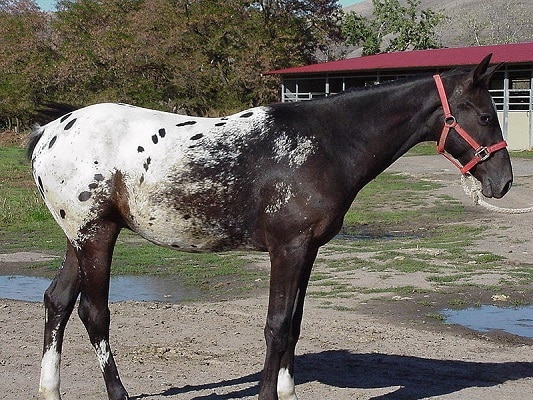
The beautiful and athletic Nez Perce Horses are bred from Appaloosas and Akhal Tekes. They often have palomino or buckskin coats overlaid with typical Appaloosa markings. This breed aims to recreate the original, fine horses of the Nez Perce people that preceded modern-day Appaloosas.
The Nez Perce Horse Breed Registry program became official in 1995. It’s ancestry and sporty conformation makes these horses excellent long-distance runners and jumpers.
Miniature Horse

Marie Charouzova / Shutterstock.com
The miniature versions of their large relatives, these tiny horses come in every possible color and body type. It’s not uncommon to spot a Miniature Horse with a full-leopard or blanket spotted coat.
Miniature Horses date back to the 17th century Europe, when they were popular pets of the nobility. Over the centuries, they have conquered the hearts of people all around the world. Soon enough every continent had its own versions of the breed.
With a height of under 34-38 inches, Miniature Horses were ideal to work in mines alongside Shetland ponies. Today, they appear in several show classes and often work as companion or guide animals.
Despite their small size, the Miniature Horse is not classified as a pony. This is because they have the proportions and characteristics of a regular horse, only scaled down.
Tiger Horse

Despite its name, the Tiger Horse has a spotted and not striped coat. The name comes from the Spanish language where there is no separate word for leopard markings.
The origins of this extremely rare gaited breed are unclear. Some sources state that its ancestors include the leopard-spotted Chinese Soulon as well as the gaited Spanish Jennet.
In 1992, Mark and Victoria Varley launched a breeding program to recreate the original Tiger Horse. They hope to achieve this by crossing Appaloosas with gaited solid-colored breeds. Its comfortable shuffling gait makes this horse ideal for ranch work that involves long hours in the saddle.
Pony of the Americas

S.M / Shutterstock.com
These popular child’s ponies originate from a stallion with Appaloosa, Arabian, and Shetland Pony ancestry.
The Pony of the Americas originates from the state of Iowa, with the official breed registry founded in 1954. Within just a few decades, the breed has seen tremendous growth with over 50,000 registered ponies by 2012. Originally a Western riding pony, the breed also performs well in endurance and English disciplines.
The height of the breed varies between 120 and 140 cm. Although deemed a “pony”, the Pony of the Americas actually resembles a small Quarter Horse cross Arabian with Appaloosa coloring.
Colorado Ranger
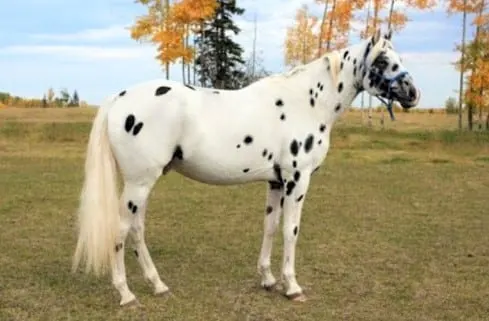
Interestingly, Colorado Rangers weren’t meant to be spotted. Native to the state of Colorado, the breed dates back to the turn of the 20th century.
Its striking coloration comes from breeding local ranch horses, including Appaloosas, to imported Turkish stallions. Over the years, leopard spotting became one of the main breeding objectives.
Colorado Rangers are born ranch horses with excellent ‘cow sense’ and endurance. They also appear on many Western and trail riding events as well as English disciplines. Colorado Rangers may also be registered as Appaloosas and approximately 90% of them are.
Walkaloosa
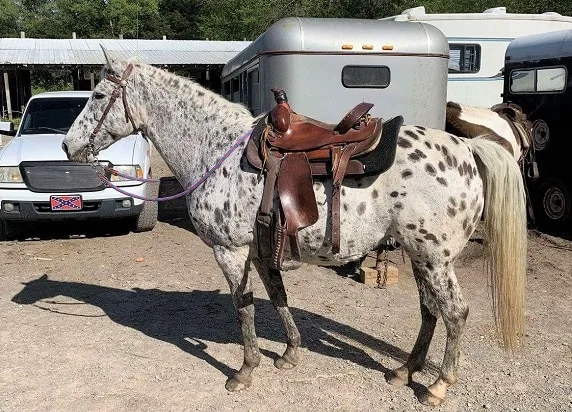
This breed unites the striking colors of the Appaloosa with the smooth going of gaited horses. Certain Appaloosa bloodlines trace back to a gaited horse breed called the Paso Fino. Hence why some Appaloosas exhibit a four-beat, ambling gait called the Indian Shuffle.
Due to showing regulations, the Appaloosa Horse Club cannot register any gaited horses. So in 1983, the Walkaloosa Horse Association was founded to help preserve this special breed.
Thanks to its remarkably comfortable gait, the Walkaloosa is the perfect choice for ranch work as well as endurance riding.
Noriker
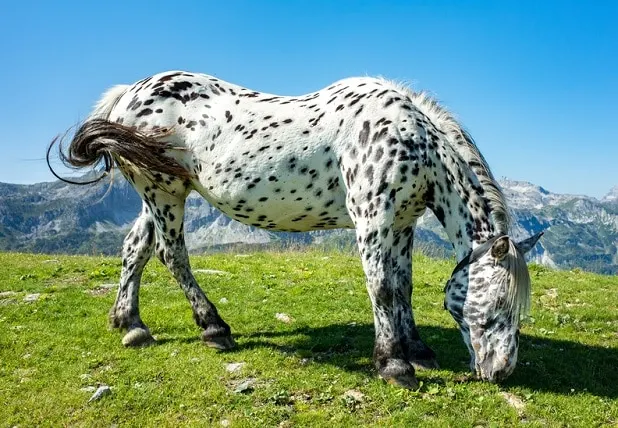
Stockr / Shutterstock.com
The only draft horse on the list, the Noriker inherited its leopard markings from prehistoric spotted horses. Norikers also exist in solid-colored, roan, tobiano, and overo versions.
Traditionally known as the Pinzgauer horse, this sure-footed Austrian breed has existed for centuries. In the 1500s, the Noriker was refined using Spanish bloodlines. Their strong effect on the breed’s confirmation is still notable today.
Up to the 20th century, the main role of Norikers was to transport goods through mountainous regions. Nowadays, they mainly carry out forestry work and carriage driving.
source: horseyhooves.com








